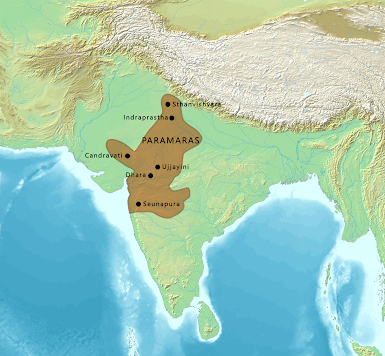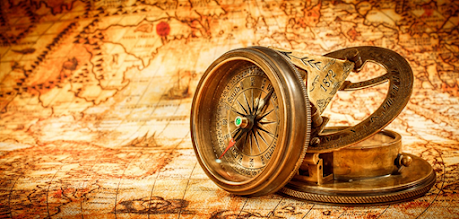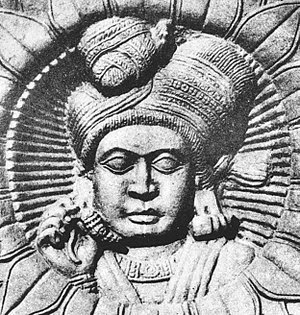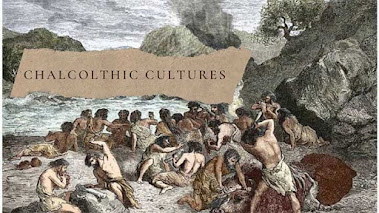The Paramara dynasty
The Paramara dynasty ruled Malwa and surrounding areas in west-central India between 9th and 14th centuries. The dynasty was established in either 9th or 10th century, and its early rulers most probably ruled as vassals of the Rashtrakutas of Manyakheta. The earliest extant Paramara inscriptions, issued by the 10th century ruler Siyaka, have been found in Gujarat.
Paramara dynasty was founded by Uppendra
Krishnaraja at the beginning of the 9th century.
Parmar (Panwar)belongs to Rajput
which was originated from the descent of Agnivansha dynasty. Paramara
meaning ‘one that strikes the enemy’. Para means alien,
enemy + mara means strike, kill. Paramara’s
origin is uncertain. Their territory was the region north of
Narmada and it was known as ‘Kingdom of Ujjain’.
- Raja Bhoj: Bhoja was the most powerful ruler of Parmara dynasty in India.
RajaBhoj was greatest in this dynasty (1018-1060).The capital of Parmara dynasty
was Dhara. Bhoja built a Saraswati temple in Dhara. Bhojsar lake was
constructed by Bhoja in Bhopal and he constructed Tribhuvana Narayana
temple in Chittore.
- His famous books were:
- 1. Ayurveda Sangraha
- Yukti
Kalpataru
- Samranga
Suthradhara(deals with architecture)
Administration:
The King was the supreme head of the government. Over the
administrative department was a body of ministers, at the head of which was the
Prime Minister, who controlled all the officials and was himself subordinate to
the king. His duty was to advise the sovereign upon matters of state, although,
of course his advice had no binding effect upon the king and could be
disregarded by him. This was the case when Eudriiditya, the minister of Munja,
was opposed to the policy of launching campaigns against the Chalukyas, and the
king disregarded his counsels.
Architecture:
The Paramara kings were great builders of magnificent cities, lakes, and temples. Bhoja rebuilt the city of Dhara. A Hoysala grant from Belur, dated 1117 A. D., records that “Dhara was made prosperous by Bhoja.’ Since his reign, it had enjoyed the position of the chief city of Malwa, even down to the time of the Muhammadan rule.
Twenty miles south of the city of Bhopal are the remains of the ancient city of Bhojpur. Tradition ascribes its foundation to Bhoja. Not far from it, to the west, is the Bhojpur lake, which was once the greatest of its kind in India. The tradition runs that Bhoja was once attacked by a malady of the severest type, which threatened his life.- No physician in the kingdom was able to cure him, but at last a recluse prescribed a remedy which, if properly applied, would definitely assure his recovery. The prescription was that the king should take a long course of baths in water supplied daily by three hundred and sixty five streams, and expert engineers were therefore sent all round the Vindhya hill to discover a place that should fulfil these conditions. After much search, the present site of the lake was discovered, which was fed by three hundred and fifty-nine springs and the deficiency in the required number was subsequently made up by turning either the courses of the river Kaliasot and its tributaries.
The king UdayAditya founded the city of Udayapur, thirty miles to the north of Bhilsa
The king Devapala built the city of Depalpur, now merely a village, about thirty miles to the north-west of Indore. He also excavated a lake, known as Depal-sagar, at one end of that village, which is now a fine sheet of water covering a space of several square miles.
During the happy reign of the Paramaras, a large number of superb and magnificent temples were built in Malwa, But, unfortunately, only a few specimens of them remain to us now. After the fall of the Paramaras, Malwa became an important centre of the Muhammadans, and the latter, in order to obtain materials for the construction of their mosques, demolished many Hindu temples. The Muhammadan historians present us with a vivid description of how lltu-Tamish sacked and ravaged the great temple of Mahakoshla at Ujjain, the object of the veneration and respect of the whole of Hindu India.
At Bhoipur. in the Bhopal State, there is a large temple of Siva known as Bhojesvara, which was evidently named after the great king Bhoja.
Bhojesvara Temple
LITERATURE AND LEARNING:
The Paramara-kings were great votaries of the Goddess of learning, and were in reality the very heart of the great literary movement of the period. Many of them were themselves great poets. Their generous sympathy encouraged others to devote their lives to the enrichment of the stores of literature. Slyaka-Harsa won imperial status for his family by the strength of his arms, and left to his successors the task of building up an ideal empire. His son, while doing full justice to his regal position by his care for the political interests of his realm, spared no effort to further the cause of the literary movement also. The Udayapur prasasti tells us that he cultivated eloquence, lofty poetry, the art of reasoning, and a complete mastery over the rules of the Saurastras.
Kalasa (1063- 1089 A. B.) and Bhoja were very learned, and were the friends of poets. The king occasionally encouraged men of letters by conferring on them honorific titles.
The Aln-i-Akbarl relates that — “Bhoja held wisdom in honour, the learned men were treated with distinction, and seekers after knowledge were encouraged by his support. Five hundred sages, the most erudite of the age, shone as the gathered wisdom of his court, and wore entertained in a manner becoming their dignity and merit.
Decline: The Paramara power rose and declined several times as a result of their struggles with the Chaulukyas of Gujarat, the Chalukyas of Kalyani, the Kalachuris of Tripuri, Chandelas of Jejakabhukti and other neighbouring kingdoms. The later Paramara rulers moved their capital to Mandapa-Durga (now Mandu) after Dhara was sacked multiple times by their enemies. Mahalakadeva, the last known Paramara king, was defeated and killed by the forces of Alauddin Khalji of Delhi in 1305 CE, although epigraphic evidence suggests that the Paramara rule continued for a few years after his death.
By: Shreyas Nikam (Team Historic Wednesday)
References:
https://trenddingtopics.wordpress.com/2018/12/27/paramara-dynasty/
https://madhyapradesh.pscnotes.com/history-booster/paramar-dynasty/
https://dbpedia.org/page/Paramara_dynasty
https://www.insightsonindia.com/medieval-indian-history/rajput-states/the-para
Image References:
https://live.staticflickr.com/6115/6383886713_516687e4c9_b.jpg
NOTE :-
This blog is meant for Educational Purpose only .We do not own any Copyrights related to images and information , all the rights goes to their respective owners . The sole purpose of this blog is to Educate, Inspire, Empower and to create awareness in the viewers. The usage is non-commercial(Not For Profit) and we do not make any money from it.
FOLLOW US ON:-
INSTAGRAM :
https://bit.ly/coep_blogs_insta
LINKEDIN:
https://bit.ly/coep_blogs_linkedIn
YOUTUBE:-
https://bit.ly/Coep_blogs_YouTube





Comments
Post a Comment